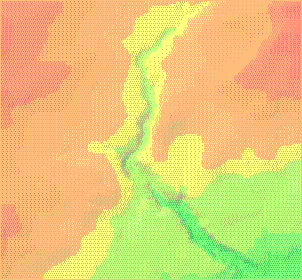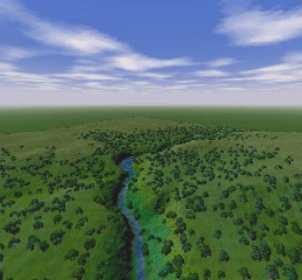
Figure 1. DEM of the lower Whittle Dene valley, Northumberland, generated by Arc/Info
In discussing the theoretical status of archaeological-GIS it is natural that we first address the basic character of the working concepts of space and time that underlie all archaeological-GIS based studies. We will take as our starting point space. Integral to and implicit within most, if not all, approaches has been a very abstracted, de-humanised concept of space. The space of the GIS is strictly Cartesian and can be conceptualised as a universal, clearly measurable and, it should be added, fundamentally external backdrop to cultural activity (Tilley 1994). Space is very much taken for granted and treated as a neutral background with no cultural value. General critical discussions of its conceptual status rarely move beyond such abstract issues as the choice of measurement units or the possible distorting effects of specific map projections.
The treatment of time again tends to be equally prescriptive, with explicit discussions as to the nature of time excluded or temporal change acknowledged and incorporated in the form of a series of discrete snapshot moments as typified by phased distribution plots or frames in an animation sequence. Like space, the question of time and temporality in GIS has been characterised by a boldly Cartesian viewpoint. This is perhaps best illustrated by a quote from the standard available reference work on time in GIS extolling the conceptual virtues of a cartographic notion of time:
I do not want to think about time in any philosophical or metaphysical sense. I am searching for operational concepts of time-concepts that will lead to its direct measurement, to better theory, and a richer set of models using time as a variable (Isard quoted in Langran 1992, 28 )
Not only are the implicit space and time of most routine GIS-based studies, and thus archaeological-GIS based studies, abstracted and largely external to the human populations under study, the categories space and time themselves tend to be regarded as exclusive. This tendency is perhaps best encapsulated by a quote from Langran when discussing the conceptual basis for a more temporally aware GIS. Here the working concepts of space and time..
..harks back to the simpler Newtonian conception of non-interacting space and time. While it may well be that a geographer's spatial and temporal dimensions do interact... spatiotemporal data are more generally useful when space and time are recorded separately (Langran 1992, 29)
These conceptual notions of space and time lie implicitly beneath the majority of routine archaeological-GIS based studies and yet have rarely been brought into critical focus. In terms of theory, it should be noted that such concepts do have their direct counterparts within the field of archaeological thought. These, however, relate directly to the more positivist spatial agendas that characterised the New or processual archaeology of the 1960s. What is important to stress here is that the conceptual stasis that can be seen to characterise routine applications of GIS has not been matched by a similar period of inactivity in terms of developments in the forms of archaeological thought. Here the intervening decades have seen a dramatic growth in studies relating to the epistemological status of archaeology, and the appearance of more reflexive modes of enquiry and encounter with the material remains of the past.
Characteristic of these developments, and standing in stark opposition to the concepts outlined above, are more complex notions of space and time that have developed and been discussed primarily in the context of landscape-based archaeological analyses (Tilley 1993, 1994; Thomas 1993), though increasingly within the broader field of archaeology as a whole (Thomas 1996). Here notions of space and time as media and outcome for human action rather than containers for it have characterised the recent archaeological and anthropological literature (Hirsch and O'Hanlon 1995). As Steiner succinctly puts it in his discussions of Heidegger's Being and Time:
We do not live "in time", as if the latter were some independent, abstract flow external to our being. We "live time"; the two terms are inseparable. (Steiner 1992, 78)
Enmeshed and embedded notions of dwelling, and spaces socially rendered in terms of significant places and pathways (Ingold 1986) rather than abstracted schema, have combined with more phenomenological discussions as to the nature and embeddedness of space and time (Gell 1992) to generate more socially enriched notions of people, environment and landscape. The limitations imposed by traditional Cartesian concepts of space and time in enabling us to approach the rich social complexity of such pasts have been questioned by a number of authors, most recently Thomas:
At a minimal level, traces of human activity must make us aware that a certain kind of existence was present in the past, although we cannot 'read-off' the meaning of place from spatial configuration alone. That is, one cannot reconstruct a past world of meaning from a Cartesian template of geometrical form (Thomas 1996, 88)
The unique time-depth and spatio-temporal dynamics that characterise many archaeological data-sets and, perhaps more importantly in the context of a developing sub-discipline such as archaeological-GIS, established critical literature pertaining to time (e.g. Bailey 1981, 1983; Shanks and Tilley 1987, 118-136) have prompted a number of discussions within the archaeological-GIS literature as to the incorporation of time within a truly temporal GIS (Castleford 1992, Miller and Halls 1995). Currently, however, this literature and more specifically worked case studies are sparse. Space has fared less well, with critical discussions of the conceptual status of the space of GIS- based analyses sorely lacking.
It is clear that if archaeologists are to utilise GIS-based approaches in their attempts to explore and articulate the archaeological record on the basis of more reflexive and experiential modes of enquiry, a more explicit discussion as to the conceptual status of the underlying space and time of the GIS is in order. The uncritically received dominance and adherence within archaeological-GIS of notions of geography and cartography as the abstract representation of the world as organised in measurable space, may have to be enriched by paying equal attention to notions of chorography, as a subject-centred sense of place (Hirsch 1995 25 notes 12-13). In addition, discussions as to the role of temporality in GIS should give equal weight to more phenomenological notions of time, what Thomas refers to as 'the time of the soul' (Thomas 1996 , 33), as to the already prevalent Kantian notions of time as an abstracted container.

Figure 1. DEM of the lower Whittle Dene valley, Northumberland, generated by Arc/Info

Figure 2. Visualisation of the lower Whittle Dene valley, Northumberland, generated using VRML
For comparison, take an Arc/Info generated DEM of the lower Whittle Dene valley, Northumberland (Figure 1), and compare it with a more experiential visualisation generated from the same source contour data (Figure 2).
© Internet Archaeology
URL: http://intarch.ac.uk/journal/issue1/gillings/part2a.html
Last updated: Tue Sep 5 1996